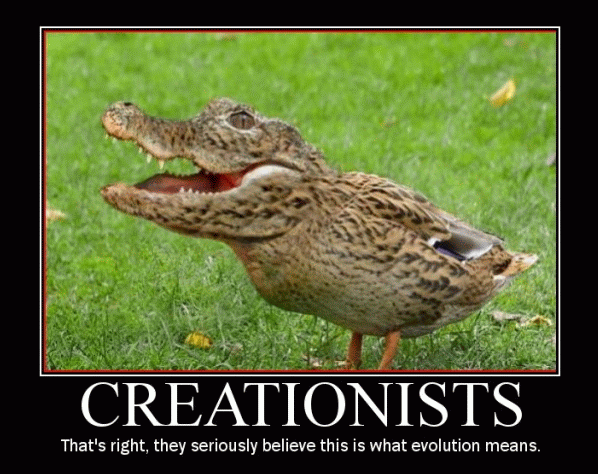OB: There is an entire field of evolutionary design and programming that contradicts this. You set up a few conditions that determine success and some basic starting point. You repeatedly generate a couple of thousand designs with small, random changes (random variation) and then pick out the ones the best fit the criteria (natural selection). You keep repeating this until you get the behavior you want. Among other things, I recall there was an antenna designed by this process, one that looked nothing like any previous antenna designed by humans, that worked better than a human-designed antenna.
PW: Not contradictory at all. You know that part "you set up a few conditions" and "You repeatedly generate" and "You keep repeating"...that's the intelligent design part.
OB: In nature, the environment sets up the conditions, without intent or intelligence. Reproduction creates the new generations, without intent or intelligence. Selection occurs, without intent or intelligence. So, if you acknowledge evolutionary design is possible at all, denying evolution in living things is self-contradictory.
Okay, let me explain this a different way.
Your comparison isn't meaningful. You can't compare "natural" (undirected) selection to "you pick out the ones that best fit your criteria" (directed) selection.
Evolutionary Design=Intelligent Design because Intelligent Design = Directed Selection
If we apply it to real world study
Selective Breeding=ID
*********
PW: Think of specified as useful patterns. The sculpted rocks of Mt. Rushmore may not have a use besides tourism, but the faces they were copied from do.
OB: Nice try to divert the topic. However, the Man in the Mountain also had an eye, nose, etc. Again, we know one was designed, and the other not, by the simplicity in the designed monument.
It ain't a diversion. Mt. Rushmore has always been a representation of the biological systems we are really talking about. The eyes on Mount Rushmore lack one important feature that biological eyes have. Usefulness.
**********
PW: Under your random/accidental system there is no reason to expect that the first place our eyes appeared were on the front of our faces. Why don't we have ancestors with eyes at the end of each boob or knee? or on the back of their heads? The existence of clunkers like that would really lend some credibility to your crazy *** theory.
OB: Actually, it would undermine it. Eyes developed long before long before boobs and knees.
Oh right. Fish have two eyes. But the first known creature to have eyes had 5 eyes. Why did 3 eyes disappear once it mutated its way into the fish? I would guess 5 eyes would make any fish more fit.
*********
PW: But seriously, you seem to be implying that any existence of "flaws" in the system negates intelligent design. The only thing "flaws" negate are purity/perfection in the design/useful pattern.
OB: Most ID advocates not not seeking to put forth the Incompetent Designer. I fully acknowledge that if you think life might have been designed by an Incompetent Designer or a Malicious Designer, than the inferior construction of living things is no bar. However, since either of those designers is consistent with any state of affiars, they can not be evidenced, either.
Actually, the Christian dogma behind The Designer is that there must be "flaws" in the design from the start or some way for "flaws" to enter the system along the way in order for humans to experience difficulties and eventual death.
I assume the original DNA code for humans was more pure so insulin resistence (<---the thing that causes "aging") took more time, so our early ancestors had longer life spans.
********
PW: Formula (*) asserts that the information in both A and B jointly is the information in A plus the information in B that is not in A. ... Either way. If you have 2 seperate books with the same story or if there are two copies of the story in one book the formula accounts for both.
OB: What the formula does not account for is the processing environment. If program A has output B in some computing environment X, it may have an entirely different output C in computing environment Y. It's not just A that contributes to B, it's both A and X. As such, B can have information derived from X that is does not exist in A, and may even have information that is not present in A or X alone, but only when the two are joined together.
The formula is just wrong in saying that laying two copies of at text, end-to-end, produces no new information. Every measure of information in use says the amount of information increases.
The processing environment is a different story...haha...but computer programs are fully deterministic so B is fully determined by A.
The amount of information may increase but the amount of new information doesn't. There are more pages in the 2 copy book but you can't learn anything more from reading the second copy of the story than you did from reading the first copy of the story.
Remember we are talking about the ability of undirected contingencies (chance) to create new information.
Formula (*) asserts that the information in both A and B jointly is the information in A plus the information in B that is not in A. Its point, therefore, is to spell out how much additional information B contributes to A. As such, this formula places tight constraints on the generation of new information. Does, for instance, a computer program, call it A, by outputting some data, call the data B, generate new information? Computer programs are fully deterministic, and so B is fully determined by A. It follows that P(B|A) = 1, and thus I(B|A) = 0 (the logarithm of 1 is always 0). From Formula (*) it therefore follows that I(A&B) = I(A), and therefore that the amount of information in A and B jointly is no more than the amount of information in A by itself.
*********
PW: You notice how you had to add an intelligent force into the equation ("you") in order to produce useful information. Same thing holds true for all of our biological parts/systems.
OB: I fully acknowledge that the division algorithm is a designed process. However, my point was that you can't claim that something is not produced by a process simply because it is not produced in any particular step. This is just as true of useful information as it is of division.
I don't believe I ever made that claim, so your point is moot.
We were talking about "Whenever chance and necessity work together..." they can't create new useful information.
********
OB: Yet, the two copies laid end-to-end still has more information.
PW:... your conclusion hasn't been backed up with logic.
OB: It's very basic information theory. 01100110 has more information than 0110. 0110011001100110 has still more.
Again, there may be more information but not new information.
********
PW: I don't think it was useful...
OB: It served, and still serves to some degree, the same purpose as Mt. Rushmore.
Yes, it served as something to look at with our real eyes. Too bad that point was just as useless as the mountain eyes.
*******
PW: That is one of the most bizarre answers I've ever seen...it is like a 50 ft. wookie.
OB: Yes human language changed over time but it originates from an intelligence source...the human mind...are you really going to deny that humans are intelligent beings?
Who directed the changes? ID is not just a claim of intelligence, but one of intelligent direction. There was no one person or group who directed the change from Old English to Middle English or Latin to Romanian. Everyone just spoke the language they learned, with small differences due to their own particulars and peculiarities (random variation). The variations that were pick up by others (reproduction) either were preserved or let go (selection). No one decided which changes to make.
ID scientists ain't claiming that the direction of change is from complex to simple.
What you are talking about is entropy of a system.
Human's made an alphabet (symbols of sounds) and created words (more complex sounds) and then strung those words together to make sentences and so forth. Then over time the language changed a little bit here and there but it was still recognized as language...and was useful for the transfer of information between humans.
This is why you can't apply "micro-evolution" to Darwin's common ancestry theory, because it is just change in creatures that already exist. It doesn't account for how those creatures came into existence.
*******
PW: The appendix was more useful hundreds of years ago when we weren't city dwellers.
OB: How so? Not everyone today is a city dweller or has significant city-dweller ancestry. Are you saying their appendixes work differently?
I'm saying depending on the environment the usefulness of the appendix changes. This is what us God-believers call adaptability.
*******
PW: So in conclusion all your "vestigial" arguments are as useless as your stories about bears falling into the ocean and becoming whales.
OB: So, you think is an organ has any sort of use at all, no matter how poorly done, duplicated, and inefficient it is at that task, it's not vestigial? I don't think you understand the term.
No, I think "vestigal" organs don't serve your fish to human claim, just your ape-like ancestor claim.
But if it supports your ape-like ancestor assumptive starting point it also supports the Bible's Adam starting point. So you unwittingly support the "creationists" you despise.



